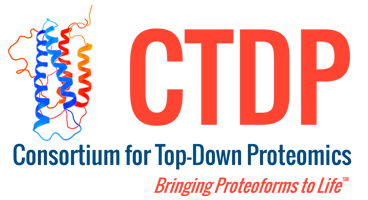“Proteomics is essential for deciphering how molecules interact as a system and for understanding the functions of cellular systems in human disease; however, the unique characteristics of the human proteome, which include a high dynamic range of protein expression and extreme complexity due to a plethora of PTMs and sequence variations, make such analyses challenging. An emerging “top-down” MS-based proteomics approach, which provides a “bird’s eye” view of all proteoforms, has unique advantages for the assessment of PTMs and sequence variations. ”
4238047
{:{9EBC6FL8}}
1
nature
50
default
1
title
43
https://ctdp.org/wp-content/plugins/zotpress/
Recent Publications
4238047
{4238047:P35C7Y43},{4238047:YS5S5DET},{4238047:D3W5KE6V},{4238047:GJRYJFVZ},{4238047:9EBC6FL8},{4238047:3V2FUS5T},{4238047:Y8LPF7C8},{4238047:DDUKW77T},{4238047:EDP7EGZK},{4238047:BAJ3AELZ}
1
annual-reviews-author-date
50
date
desc
1
title
43
https://ctdp.org/wp-content/plugins/zotpress/
%7B%22status%22%3A%22success%22%2C%22updateneeded%22%3Afalse%2C%22instance%22%3Afalse%2C%22meta%22%3A%7B%22request_last%22%3A0%2C%22request_next%22%3A0%2C%22used_cache%22%3Atrue%7D%2C%22data%22%3A%5B%7B%22key%22%3A%223V2FUS5T%22%2C%22library%22%3A%7B%22id%22%3A4238047%7D%2C%22meta%22%3A%7B%22creatorSummary%22%3A%22Jin%20et%20al.%22%2C%22parsedDate%22%3A%222017-05-02%22%2C%22numChildren%22%3A0%7D%2C%22bib%22%3A%22%26lt%3Bdiv%20class%3D%26quot%3Bcsl-bib-body%26quot%3B%20style%3D%26quot%3Bline-height%3A%202%3B%20padding-left%3A%201em%3B%20text-indent%3A-1em%3B%26quot%3B%26gt%3B%5Cn%20%26lt%3Bdiv%20class%3D%26quot%3Bcsl-entry%26quot%3B%26gt%3BJin%20Y%2C%20Wei%20L%2C%20Cai%20W%2C%20Lin%20Z%2C%20Wu%20Z%2C%20et%20al.%202017.%20%26lt%3Ba%20class%3D%26%23039%3Bzp-ItemURL%26%23039%3B%20target%3D%26%23039%3B_blank%26%23039%3B%20href%3D%26%23039%3Bhttp%3A%5C%2F%5C%2Fdx.doi.org%5C%2F10.1021%5C%2Facs.analchem.7b00113%26%23039%3B%26gt%3BComplete%20Characterization%20of%20Cardiac%20Myosin%20Heavy%20Chain%20%28223%20kDa%29%20Enabled%20by%20Size-Exclusion%20Chromatography%20and%20Middle-Down%20Mass%20Spectrometry%26lt%3B%5C%2Fa%26gt%3B.%20%26lt%3Bi%26gt%3BAnal.%20Chem.%26lt%3B%5C%2Fi%26gt%3B%2089%289%29%3A4922%5Cu201330%26lt%3B%5C%2Fdiv%26gt%3B%5Cn%26lt%3B%5C%2Fdiv%26gt%3B%22%2C%22data%22%3A%7B%22itemType%22%3A%22journalArticle%22%2C%22title%22%3A%22Complete%20Characterization%20of%20Cardiac%20Myosin%20Heavy%20Chain%20%28223%20kDa%29%20Enabled%20by%20Size-Exclusion%20Chromatography%20and%20Middle-Down%20Mass%20Spectrometry%22%2C%22creators%22%3A%5B%7B%22creatorType%22%3A%22author%22%2C%22firstName%22%3A%22Yutong%22%2C%22lastName%22%3A%22Jin%22%7D%2C%7B%22creatorType%22%3A%22author%22%2C%22firstName%22%3A%22Liming%22%2C%22lastName%22%3A%22Wei%22%7D%2C%7B%22creatorType%22%3A%22author%22%2C%22firstName%22%3A%22Wenxuan%22%2C%22lastName%22%3A%22Cai%22%7D%2C%7B%22creatorType%22%3A%22author%22%2C%22firstName%22%3A%22Ziqing%22%2C%22lastName%22%3A%22Lin%22%7D%2C%7B%22creatorType%22%3A%22author%22%2C%22firstName%22%3A%22Zhijie%22%2C%22lastName%22%3A%22Wu%22%7D%2C%7B%22creatorType%22%3A%22author%22%2C%22firstName%22%3A%22Ying%22%2C%22lastName%22%3A%22Peng%22%7D%2C%7B%22creatorType%22%3A%22author%22%2C%22firstName%22%3A%22Takushi%22%2C%22lastName%22%3A%22Kohmoto%22%7D%2C%7B%22creatorType%22%3A%22author%22%2C%22firstName%22%3A%22Richard%20L.%22%2C%22lastName%22%3A%22Moss%22%7D%2C%7B%22creatorType%22%3A%22author%22%2C%22firstName%22%3A%22Ying%22%2C%22lastName%22%3A%22Ge%22%7D%5D%2C%22abstractNote%22%3A%22Myosin%20heavy%20chain%20%28MHC%29%2C%20the%20major%20component%20of%20the%20myosin%20motor%20molecule%2C%20plays%20an%20essential%20role%20in%20force%20production%20during%20muscle%20contraction.%20However%2C%20a%20comprehensive%20analysis%20of%20MHC%20proteoforms%20arising%20from%20sequence%20variations%20and%20post-translational%20modifications%20%28PTMs%29%20remains%20challenging%20due%20to%20the%20difficulties%20in%20purifying%20MHC%20%28%5Cu223c223%20kDa%29%20and%20achieving%20complete%20sequence%20coverage.%20Herein%2C%20we%20have%20established%20a%20strategy%20to%20effectively%20purify%20and%20comprehensively%20characterize%20MHC%20from%20heart%20tissue%20by%20combining%20size-exclusion%20chromatography%20%28SEC%29%20and%20middle-down%20mass%20spectrometry%20%28MS%29.%20First%2C%20we%20have%20developed%20a%20MS-compatible%20SEC%20method%20for%20purifying%20MHC%20from%20heart%20tissue%20with%20high%20efficiency.%20Next%2C%20we%20have%20optimized%20the%20Glu-C%2C%20Asp-N%2C%20and%20trypsin%20limited%20digestion%20conditions%20for%20middle-down%20MS.%20Subsequently%2C%20we%20have%20applied%20this%20strategy%20with%20optimized%20conditions%20to%20comprehensively%20characterize%20human%20MHC%20and%20identified%20%5Cu03b2-MHC%20as%20the%20predominant%20isoform%20in%20human%20left%20ventricular%20tissue.%20Full%20sequence%20coverage%20based%20on%20highly%20accurate%20mass%20measurements%20has%20been%20achieved%20using%20middle-down%20MS%20combining%201%20Glu-C%2C%201%20Asp-N%2C%20and%201%20trypsin%20digestion.%20Three%20different%20PTMs%3A%20acetylation%2C%20methylation%2C%20and%20trimethylation%20were%20identified%20in%20human%20%5Cu03b2-MHC%20and%20the%20corresponding%20sites%20were%20localized%20to%20the%20N-terminal%20Gly%2C%20Lys34%2C%20and%20Lys129%2C%20respectively%2C%20by%20electron%20capture%20dissociation%20%28ECD%29.%20Taken%20together%2C%20we%20have%20demonstrated%20this%20strategy%20is%20highly%20efficient%20for%20purification%20and%20characterization%20of%20MHC%2C%20which%20can%20be%20further%20applied%20to%20studies%20of%20the%20role%20of%20MHC%20proteoforms%20in%20muscle-related%20diseases.%20We%20also%20envision%20that%20this%20integrated%20SEC%5C%2Fmiddle-down%20MS%20strategy%20can%20be%20extended%20for%20the%20characterization%20of%20other%20large%20proteins%20over%20200%20kDa.%22%2C%22date%22%3A%22May%202%2C%202017%22%2C%22language%22%3A%22%22%2C%22DOI%22%3A%2210.1021%5C%2Facs.analchem.7b00113%22%2C%22ISSN%22%3A%220003-2700%22%2C%22url%22%3A%22http%3A%5C%2F%5C%2Fdx.doi.org%5C%2F10.1021%5C%2Facs.analchem.7b00113%22%2C%22collections%22%3A%5B%5D%2C%22dateModified%22%3A%222017-09-11T20%3A46%3A17Z%22%7D%7D%2C%7B%22key%22%3A%22P35C7Y43%22%2C%22library%22%3A%7B%22id%22%3A4238047%7D%2C%22meta%22%3A%7B%22creatorSummary%22%3A%22Fornelli%20et%20al.%22%2C%22parsedDate%22%3A%222017-02-07%22%2C%22numChildren%22%3A0%7D%2C%22bib%22%3A%22%26lt%3Bdiv%20class%3D%26quot%3Bcsl-bib-body%26quot%3B%20style%3D%26quot%3Bline-height%3A%202%3B%20padding-left%3A%201em%3B%20text-indent%3A-1em%3B%26quot%3B%26gt%3B%5Cn%20%26lt%3Bdiv%20class%3D%26quot%3Bcsl-entry%26quot%3B%26gt%3BFornelli%20L%2C%20Toby%20TK%2C%20Schachner%20LF%2C%20Doubleday%20PF%2C%20Srzenti%5Cu0107%20K%2C%20et%20al.%202017.%20%26lt%3Ba%20class%3D%26%23039%3Bzp-ItemURL%26%23039%3B%20target%3D%26%23039%3B_blank%26%23039%3B%20href%3D%26%23039%3Bhttp%3A%5C%2F%5C%2Fwww.sciencedirect.com%5C%2Fscience%5C%2Farticle%5C%2Fpii%5C%2FS1874391917300428%26%23039%3B%26gt%3BTop-down%20proteomics%3A%20Where%20we%20are%2C%20where%20we%20are%20going%3F%26lt%3B%5C%2Fa%26gt%3B%20%26lt%3Bi%26gt%3BJournal%20of%20Proteomics%26lt%3B%5C%2Fi%26gt%3B%26lt%3B%5C%2Fdiv%26gt%3B%5Cn%26lt%3B%5C%2Fdiv%26gt%3B%22%2C%22data%22%3A%7B%22itemType%22%3A%22journalArticle%22%2C%22title%22%3A%22Top-down%20proteomics%3A%20Where%20we%20are%2C%20where%20we%20are%20going%3F%22%2C%22creators%22%3A%5B%7B%22creatorType%22%3A%22author%22%2C%22firstName%22%3A%22Luca%22%2C%22lastName%22%3A%22Fornelli%22%7D%2C%7B%22creatorType%22%3A%22author%22%2C%22firstName%22%3A%22Timothy%20K.%22%2C%22lastName%22%3A%22Toby%22%7D%2C%7B%22creatorType%22%3A%22author%22%2C%22firstName%22%3A%22Luis%20F.%22%2C%22lastName%22%3A%22Schachner%22%7D%2C%7B%22creatorType%22%3A%22author%22%2C%22firstName%22%3A%22Peter%20F.%22%2C%22lastName%22%3A%22Doubleday%22%7D%2C%7B%22creatorType%22%3A%22author%22%2C%22firstName%22%3A%22Kristina%22%2C%22lastName%22%3A%22Srzenti%5Cu0107%22%7D%2C%7B%22creatorType%22%3A%22author%22%2C%22firstName%22%3A%22Caroline%20J.%22%2C%22lastName%22%3A%22DeHart%22%7D%2C%7B%22creatorType%22%3A%22author%22%2C%22firstName%22%3A%22Neil%20L.%22%2C%22lastName%22%3A%22Kelleher%22%7D%5D%2C%22abstractNote%22%3A%22%22%2C%22date%22%3A%22February%207%2C%202017%22%2C%22language%22%3A%22%22%2C%22DOI%22%3A%2210.1016%5C%2Fj.jprot.2017.02.002%22%2C%22ISSN%22%3A%221874-3919%22%2C%22url%22%3A%22http%3A%5C%2F%5C%2Fwww.sciencedirect.com%5C%2Fscience%5C%2Farticle%5C%2Fpii%5C%2FS1874391917300428%22%2C%22collections%22%3A%5B%5D%2C%22dateModified%22%3A%222017-09-11T21%3A20%3A08Z%22%7D%7D%2C%7B%22key%22%3A%22EDP7EGZK%22%2C%22library%22%3A%7B%22id%22%3A4238047%7D%2C%22meta%22%3A%7B%22creatorSummary%22%3A%22Fagerquist%20and%20Zaragoza%22%2C%22parsedDate%22%3A%222016-03-30%22%2C%22numChildren%22%3A0%7D%2C%22bib%22%3A%22%26lt%3Bdiv%20class%3D%26quot%3Bcsl-bib-body%26quot%3B%20style%3D%26quot%3Bline-height%3A%202%3B%20padding-left%3A%201em%3B%20text-indent%3A-1em%3B%26quot%3B%26gt%3B%5Cn%20%26lt%3Bdiv%20class%3D%26quot%3Bcsl-entry%26quot%3B%26gt%3BFagerquist%20CK%2C%20Zaragoza%20WJ.%202016.%20%26lt%3Ba%20class%3D%26%23039%3Bzp-ItemURL%26%23039%3B%20target%3D%26%23039%3B_blank%26%23039%3B%20href%3D%26%23039%3Bhttp%3A%5C%2F%5C%2Fonlinelibrary.wiley.com%5C%2Fdoi%5C%2F10.1002%5C%2Frcm.7507%5C%2Fabstract%26%23039%3B%26gt%3BBacteriophage%20cell%20lysis%20of%20Shiga%20toxin-producing%20Escherichia%20coli%20for%20top-down%20proteomic%20identification%20of%20Shiga%20toxins%201%20%26amp%3B%202%20using%20matrix-assisted%20laser%20desorption%5C%2Fionization%20tandem%20time-of-flight%20mass%20spectrometry%26lt%3B%5C%2Fa%26gt%3B.%20%26lt%3Bi%26gt%3BRapid%20Commun.%20Mass%20Spectrom.%26lt%3B%5C%2Fi%26gt%3B%2030%286%29%3A671%5Cu201380%26lt%3B%5C%2Fdiv%26gt%3B%5Cn%26lt%3B%5C%2Fdiv%26gt%3B%22%2C%22data%22%3A%7B%22itemType%22%3A%22journalArticle%22%2C%22title%22%3A%22Bacteriophage%20cell%20lysis%20of%20Shiga%20toxin-producing%20Escherichia%20coli%20for%20top-down%20proteomic%20identification%20of%20Shiga%20toxins%201%20%26%202%20using%20matrix-assisted%20laser%20desorption%5C%2Fionization%20tandem%20time-of-flight%20mass%20spectrometry%22%2C%22creators%22%3A%5B%7B%22creatorType%22%3A%22author%22%2C%22firstName%22%3A%22Clifton%20K.%22%2C%22lastName%22%3A%22Fagerquist%22%7D%2C%7B%22creatorType%22%3A%22author%22%2C%22firstName%22%3A%22William%20J.%22%2C%22lastName%22%3A%22Zaragoza%22%7D%5D%2C%22abstractNote%22%3A%22Rational%5Cn%5CnAnalysis%20of%20bacteria%20by%20matrix-assisted%20laser%20desorption%5C%2Fionization%20time-of-flight%20mass%20spectrometry%20%28MALDI-TOFMS%29%20often%20relies%20upon%20sample%20preparation%20methods%20that%20result%20in%20cell%20lysis%2C%20e.g.%20bead-beating.%20However%2C%20Shiga%20toxin-producing%20Escherichia%20coli%20%28STEC%29%20can%20undergo%20bacteriophage-induced%20cell%20lysis%20triggered%20by%20antibiotic%20exposure%20that%20may%20allow%20greater%20selectivity%20of%20the%20proteins%20extracted.%5Cn%5Cn%5CnMethods%5Cn%5CnWe%20have%20developed%20a%20sample%20preparation%20method%20for%20selective%20extraction%20of%20bacteriophage-encoded%20proteins%20and%20specifically%20Shiga%20toxins%201%20and%202%20%28Stx1%20%26amp%3B%202%29%20expressed%20from%20STEC%20strains%20induced%20by%20DNA-damaging%20antibiotics.%20STEC%20strains%20were%20cultured%20overnight%20on%20agar%20supplemented%20with%20ciprofloxacin%2C%20mitomycin-C%20or%20an%20iron%20chelator%20to%20induce%20the%20bacteriophage%20lytic%20cycle%20with%20concomitant%20expression%20and%20release%20of%20Stx1%20and%5C%2For%20Stx2.%20Sample%20preparation%20relied%20exclusively%20on%20bacteriophage%20lysis%20for%20release%20Stx%20into%20the%20extraction%20solution.%5Cn%5Cn%5CnResults%5Cn%5CnThree%20clinical%20STEC%20strains%20were%20analyzed%20by%20matrix-assisted%20laser%20desorption%5C%2Fionization%20tandem%20time-of-flight%20mass%20spectrometry%20%28MALDI-TOF-TOF-MS%5C%2FMS%29%20and%20top-down%20proteomics%20analysis%3A%20E.%20coli%20O157%3AH7%20strain%20EDL933%2C%20E.%20coli%20O91%3AH21%20strain%20B2F1%20and%20E.%20coli%20O26%3AH11%20strain%20ECRC%20%2305.2217.%20The%20B-subunit%20of%20Stx1a%20of%20EDL933%20was%20detected%20and%20identified%20even%20though%20it%20was%20~100-fold%20less%20abundant%20than%20the%20B-subunit%20of%20Stx2a%20that%20had%20been%20identified%20previously%20for%20this%20strain.%20Two%20bacteriophage-encoded%20proteins%20were%20also%20identified%3A%20L0117%20and%20L0136.%20The%20B-subunits%20of%20Stx2d%20of%20strain%20B2F1%20and%20Stx1a%20of%20strain%20ECRC%20%2305.2217%20were%20also%20detected%20and%20identified.%5Cn%5Cn%5CnConclusions%5Cn%5CnBacteriophage%20lysis%20appeared%20to%20enhance%20the%20detection%20sensitivity%20of%20Stx%20for%20these%20STEC%20strains%20compared%20to%20previous%20work%20using%20mechanical%20lysis.%20Detection%5C%2Fidentification%20of%20other%20bacteriophage-encoded%20proteins%20%28beyond%20Stx%29%20tends%20to%20support%20the%20hypothesis%20of%20Stx%20release%20by%20bacteriophage%20cell%20lysis.%20Published%20in%202016.%20This%20article%20is%20a%20U.S.%20Government%20work%20and%20is%20in%20the%20public%20domain%20in%20the%20USA.%22%2C%22date%22%3A%22March%2030%2C%202016%22%2C%22language%22%3A%22en%22%2C%22DOI%22%3A%2210.1002%5C%2Frcm.7507%22%2C%22ISSN%22%3A%221097-0231%22%2C%22url%22%3A%22http%3A%5C%2F%5C%2Fonlinelibrary.wiley.com%5C%2Fdoi%5C%2F10.1002%5C%2Frcm.7507%5C%2Fabstract%22%2C%22collections%22%3A%5B%5D%2C%22dateModified%22%3A%222017-09-08T14%3A59%3A13Z%22%7D%7D%2C%7B%22key%22%3A%22BAJ3AELZ%22%2C%22library%22%3A%7B%22id%22%3A4238047%7D%2C%22meta%22%3A%7B%22creatorSummary%22%3A%22Tran%20et%20al.%22%2C%22parsedDate%22%3A%222016-02-16%22%2C%22numChildren%22%3A0%7D%2C%22bib%22%3A%22%26lt%3Bdiv%20class%3D%26quot%3Bcsl-bib-body%26quot%3B%20style%3D%26quot%3Bline-height%3A%202%3B%20padding-left%3A%201em%3B%20text-indent%3A-1em%3B%26quot%3B%26gt%3B%5Cn%20%26lt%3Bdiv%20class%3D%26quot%3Bcsl-entry%26quot%3B%26gt%3BTran%20BQ%2C%20Barton%20C%2C%20Feng%20J%2C%20Sandjong%20A%2C%20Yoon%20SH%2C%20et%20al.%202016.%20%26lt%3Ba%20class%3D%26%23039%3Bzp-ItemURL%26%23039%3B%20target%3D%26%23039%3B_blank%26%23039%3B%20href%3D%26%23039%3Bhttp%3A%5C%2F%5C%2Fwww.sciencedirect.com%5C%2Fscience%5C%2Farticle%5C%2Fpii%5C%2FS1874391915301640%26%23039%3B%26gt%3BComprehensive%20glycosylation%20profiling%20of%20IgG%20and%20IgG-fusion%20proteins%20by%20top-down%20MS%20with%20multiple%20fragmentation%20techniques%26lt%3B%5C%2Fa%26gt%3B.%20%26lt%3Bi%26gt%3BJournal%20of%20Proteomics%26lt%3B%5C%2Fi%26gt%3B.%20134%3A93%5Cu2013101%26lt%3B%5C%2Fdiv%26gt%3B%5Cn%26lt%3B%5C%2Fdiv%26gt%3B%22%2C%22data%22%3A%7B%22itemType%22%3A%22journalArticle%22%2C%22title%22%3A%22Comprehensive%20glycosylation%20profiling%20of%20IgG%20and%20IgG-fusion%20proteins%20by%20top-down%20MS%20with%20multiple%20fragmentation%20techniques%22%2C%22creators%22%3A%5B%7B%22creatorType%22%3A%22author%22%2C%22firstName%22%3A%22Bao%20Quoc%22%2C%22lastName%22%3A%22Tran%22%7D%2C%7B%22creatorType%22%3A%22author%22%2C%22firstName%22%3A%22Christopher%22%2C%22lastName%22%3A%22Barton%22%7D%2C%7B%22creatorType%22%3A%22author%22%2C%22firstName%22%3A%22Jinhua%22%2C%22lastName%22%3A%22Feng%22%7D%2C%7B%22creatorType%22%3A%22author%22%2C%22firstName%22%3A%22Aimee%22%2C%22lastName%22%3A%22Sandjong%22%7D%2C%7B%22creatorType%22%3A%22author%22%2C%22firstName%22%3A%22Sung%20Hwan%22%2C%22lastName%22%3A%22Yoon%22%7D%2C%7B%22creatorType%22%3A%22author%22%2C%22firstName%22%3A%22Shivangi%22%2C%22lastName%22%3A%22Awasthi%22%7D%2C%7B%22creatorType%22%3A%22author%22%2C%22firstName%22%3A%22Tao%22%2C%22lastName%22%3A%22Liang%22%7D%2C%7B%22creatorType%22%3A%22author%22%2C%22firstName%22%3A%22Mohd%20M.%22%2C%22lastName%22%3A%22Khan%22%7D%2C%7B%22creatorType%22%3A%22author%22%2C%22firstName%22%3A%22David%20P.%20A.%22%2C%22lastName%22%3A%22Kilgour%22%7D%2C%7B%22creatorType%22%3A%22author%22%2C%22firstName%22%3A%22David%20R.%22%2C%22lastName%22%3A%22Goodlett%22%7D%2C%7B%22creatorType%22%3A%22author%22%2C%22firstName%22%3A%22Young%20Ah%22%2C%22lastName%22%3A%22Goo%22%7D%5D%2C%22abstractNote%22%3A%22We%20employed%20top-%20and%20middle-down%20analyses%20with%20multiple%20fragmentation%20techniques%20including%20electron%20transfer%20dissociation%20%28ETD%29%2C%20electron%20capture%20dissociation%20%28ECD%29%2C%20and%20matrix-assisted%20laser%20desorption%20ionization%20in-source%20decay%20%28MALDI-ISD%29%20for%20characterization%20of%20a%20reference%20monoclonal%20antibody%20%28mAb%29%20IgG1%20and%20a%20fusion%20IgG%20protein.%20Fourier%20transform%20ion%20cyclotron%20resonance%20%28FT-ICR%29%20or%20high%20performance%20liquid%20chromatography%20electrospray%20ionization%20%28HPLC-ESI%29%20on%20an%20Orbitrap%20was%20employed.%20These%20experiments%20provided%20a%20comprehensive%20view%20on%20the%20protein%20species%3B%20especially%20for%20different%20glycosylation%20level%20in%20these%20two%20proteins%2C%20which%20showed%20good%20agreement%20with%20oligosaccharide%20profiling.%20Top-%20and%20middle-down%20MS%20provided%20additional%20information%20regarding%20glycosylation%20sites%20and%20different%20combinational%20protein%20species%20that%20were%20not%20available%20from%20oligosaccharide%20mapping%20or%20conventional%20bottom-up%20analysis.%20Finally%2C%20incorporating%20a%20limited%20enzymatic%20digestion%20by%20immunoglobulin%20G-degrading%20enzyme%20of%20Streptococcus%20pyogene%20%28IdeS%29%20with%20MALDI-ISD%20analysis%20enabled%20extended%20sequence%20coverage%20of%20the%20internal%20region%20of%20protein%20without%20pre-fractionation.%20Oligosaccharide%20profiling%20together%20with%20top-%20and%20middle-down%20methods%20enabled%3A%201%29%20detection%20of%20heterogeneous%20glycosylated%20protein%20species%20and%20sites%20in%20intact%20IgG1%20and%20fusion%20proteins%20with%20high%20mass%20accuracy%2C%202%29%20estimation%20of%20relative%20abundance%20levels%20of%20protein%20species%20in%20the%20sample%2C%203%29%20confirmation%20of%20the%20protein%20termini%20structural%20information%2C%20and%204%29%20improved%20sequence%20coverage%20by%20MALDI-ISD%20analysis%20for%20the%20internal%20regions%20of%20the%20proteins%20without%20sample%20pre-fractionation.%22%2C%22date%22%3A%22February%2016%2C%202016%22%2C%22language%22%3A%22%22%2C%22DOI%22%3A%2210.1016%5C%2Fj.jprot.2015.10.021%22%2C%22ISSN%22%3A%221874-3919%22%2C%22url%22%3A%22http%3A%5C%2F%5C%2Fwww.sciencedirect.com%5C%2Fscience%5C%2Farticle%5C%2Fpii%5C%2FS1874391915301640%22%2C%22collections%22%3A%5B%5D%2C%22dateModified%22%3A%222017-09-08T15%3A09%3A47Z%22%7D%7D%2C%7B%22key%22%3A%22DDUKW77T%22%2C%22library%22%3A%7B%22id%22%3A4238047%7D%2C%22meta%22%3A%7B%22creatorSummary%22%3A%22Dang%20et%20al.%22%2C%22parsedDate%22%3A%222014-05-01%22%2C%22numChildren%22%3A0%7D%2C%22bib%22%3A%22%26lt%3Bdiv%20class%3D%26quot%3Bcsl-bib-body%26quot%3B%20style%3D%26quot%3Bline-height%3A%202%3B%20padding-left%3A%201em%3B%20text-indent%3A-1em%3B%26quot%3B%26gt%3B%5Cn%20%26lt%3Bdiv%20class%3D%26quot%3Bcsl-entry%26quot%3B%26gt%3BDang%20X%2C%20Scotcher%20J%2C%20Wu%20S%2C%20Chu%20RK%2C%20Toli%5Cu0107%20N%2C%20et%20al.%202014.%20%26lt%3Ba%20class%3D%26%23039%3Bzp-ItemURL%26%23039%3B%20target%3D%26%23039%3B_blank%26%23039%3B%20href%3D%26%23039%3Bhttp%3A%5C%2F%5C%2Fonlinelibrary.wiley.com%5C%2Fdoi%5C%2F10.1002%5C%2Fpmic.201300438%5C%2Fabstract%26%23039%3B%26gt%3BThe%20first%20pilot%20project%20of%20the%20consortium%20for%20top-down%20proteomics%3A%20A%20status%20report%26lt%3B%5C%2Fa%26gt%3B.%20%26lt%3Bi%26gt%3BProteomics%26lt%3B%5C%2Fi%26gt%3B.%2014%2810%29%3A1130%5Cu201340%26lt%3B%5C%2Fdiv%26gt%3B%5Cn%26lt%3B%5C%2Fdiv%26gt%3B%22%2C%22data%22%3A%7B%22itemType%22%3A%22journalArticle%22%2C%22title%22%3A%22The%20first%20pilot%20project%20of%20the%20consortium%20for%20top-down%20proteomics%3A%20A%20status%20report%22%2C%22creators%22%3A%5B%7B%22creatorType%22%3A%22author%22%2C%22firstName%22%3A%22Xibei%22%2C%22lastName%22%3A%22Dang%22%7D%2C%7B%22creatorType%22%3A%22author%22%2C%22firstName%22%3A%22Jenna%22%2C%22lastName%22%3A%22Scotcher%22%7D%2C%7B%22creatorType%22%3A%22author%22%2C%22firstName%22%3A%22Si%22%2C%22lastName%22%3A%22Wu%22%7D%2C%7B%22creatorType%22%3A%22author%22%2C%22firstName%22%3A%22Rosalie%20K.%22%2C%22lastName%22%3A%22Chu%22%7D%2C%7B%22creatorType%22%3A%22author%22%2C%22firstName%22%3A%22Nikola%22%2C%22lastName%22%3A%22Toli%5Cu0107%22%7D%2C%7B%22creatorType%22%3A%22author%22%2C%22firstName%22%3A%22Ioanna%22%2C%22lastName%22%3A%22Ntai%22%7D%2C%7B%22creatorType%22%3A%22author%22%2C%22firstName%22%3A%22Paul%20M.%22%2C%22lastName%22%3A%22Thomas%22%7D%2C%7B%22creatorType%22%3A%22author%22%2C%22firstName%22%3A%22Ryan%20T.%22%2C%22lastName%22%3A%22Fellers%22%7D%2C%7B%22creatorType%22%3A%22author%22%2C%22firstName%22%3A%22Bryan%20P.%22%2C%22lastName%22%3A%22Early%22%7D%2C%7B%22creatorType%22%3A%22author%22%2C%22firstName%22%3A%22Yupeng%22%2C%22lastName%22%3A%22Zheng%22%7D%2C%7B%22creatorType%22%3A%22author%22%2C%22firstName%22%3A%22Kenneth%20R.%22%2C%22lastName%22%3A%22Durbin%22%7D%2C%7B%22creatorType%22%3A%22author%22%2C%22firstName%22%3A%22Richard%20D.%22%2C%22lastName%22%3A%22LeDuc%22%7D%2C%7B%22creatorType%22%3A%22author%22%2C%22firstName%22%3A%22Jeremy%20J.%22%2C%22lastName%22%3A%22Wolff%22%7D%2C%7B%22creatorType%22%3A%22author%22%2C%22firstName%22%3A%22Christopher%20J.%22%2C%22lastName%22%3A%22Thompson%22%7D%2C%7B%22creatorType%22%3A%22author%22%2C%22firstName%22%3A%22Jingxi%22%2C%22lastName%22%3A%22Pan%22%7D%2C%7B%22creatorType%22%3A%22author%22%2C%22firstName%22%3A%22Jun%22%2C%22lastName%22%3A%22Han%22%7D%2C%7B%22creatorType%22%3A%22author%22%2C%22firstName%22%3A%22Jared%20B.%22%2C%22lastName%22%3A%22Shaw%22%7D%2C%7B%22creatorType%22%3A%22author%22%2C%22firstName%22%3A%22Joseph%20P.%22%2C%22lastName%22%3A%22Salisbury%22%7D%2C%7B%22creatorType%22%3A%22author%22%2C%22firstName%22%3A%22Michael%22%2C%22lastName%22%3A%22Easterling%22%7D%2C%7B%22creatorType%22%3A%22author%22%2C%22firstName%22%3A%22Christoph%20H.%22%2C%22lastName%22%3A%22Borchers%22%7D%2C%7B%22creatorType%22%3A%22author%22%2C%22firstName%22%3A%22Jennifer%20S.%22%2C%22lastName%22%3A%22Brodbelt%22%7D%2C%7B%22creatorType%22%3A%22author%22%2C%22firstName%22%3A%22Jeffery%20N.%22%2C%22lastName%22%3A%22Agar%22%7D%2C%7B%22creatorType%22%3A%22author%22%2C%22firstName%22%3A%22Ljiljana%22%2C%22lastName%22%3A%22Pa%5Cu0161a-Toli%5Cu0107%22%7D%2C%7B%22creatorType%22%3A%22author%22%2C%22firstName%22%3A%22Neil%20L.%22%2C%22lastName%22%3A%22Kelleher%22%7D%2C%7B%22creatorType%22%3A%22author%22%2C%22firstName%22%3A%22Nicolas%20L.%22%2C%22lastName%22%3A%22Young%22%7D%5D%2C%22abstractNote%22%3A%22Pilot%20Project%20%231%5Cu2014the%20identification%20and%20characterization%20of%20human%20histone%20H4%20proteoforms%20by%20top-down%20MS%5Cu2014is%20the%20first%20project%20launched%20by%20the%20Consortium%20for%20Top-Down%20Proteomics%20%28CTDP%29%20to%20refine%20and%20validate%20top-down%20MS.%20Within%20the%20initial%20results%20from%20seven%20participating%20laboratories%2C%20all%20reported%20the%20probability-based%20identification%20of%20human%20histone%20H4%20%28UniProt%20accession%20P62805%29%20with%20expectation%20values%20ranging%20from%2010%5Cu221213%20to%2010%5Cu2212105.%20Regarding%20characterization%2C%20a%20total%20of%2074%20proteoforms%20were%20reported%2C%20with%2021%20done%20so%20unambiguously%3B%20one%20new%20PTM%2C%20K79ac%2C%20was%20identified.%20Inter-laboratory%20comparison%20reveals%20aspects%20of%20the%20results%20that%20are%20consistent%2C%20such%20as%20the%20localization%20of%20individual%20PTMs%20and%20binary%20combinations%2C%20while%20other%20aspects%20are%20more%20variable%2C%20such%20as%20the%20accurate%20characterization%20of%20low-abundance%20proteoforms%20harboring%20%26gt%3B2%20PTMs.%20An%20open-access%20tool%20and%20discussion%20of%20proteoform%20scoring%20are%20included%2C%20along%20with%20a%20description%20of%20general%20challenges%20that%20lie%20ahead%20including%20improved%20proteoform%20separations%20prior%20to%20mass%20spectrometric%20analysis%2C%20better%20instrumentation%20performance%2C%20and%20software%20development.%22%2C%22date%22%3A%22May%201%2C%202014%22%2C%22language%22%3A%22en%22%2C%22DOI%22%3A%2210.1002%5C%2Fpmic.201300438%22%2C%22ISSN%22%3A%221615-9861%22%2C%22url%22%3A%22http%3A%5C%2F%5C%2Fonlinelibrary.wiley.com%5C%2Fdoi%5C%2F10.1002%5C%2Fpmic.201300438%5C%2Fabstract%22%2C%22collections%22%3A%5B%5D%2C%22dateModified%22%3A%222017-09-08T15%3A30%3A35Z%22%7D%7D%2C%7B%22key%22%3A%229EBC6FL8%22%2C%22library%22%3A%7B%22id%22%3A4238047%7D%2C%22meta%22%3A%7B%22creatorSummary%22%3A%22Gregorich%20and%20Ge%22%2C%22parsedDate%22%3A%222014-05-01%22%2C%22numChildren%22%3A0%7D%2C%22bib%22%3A%22%26lt%3Bdiv%20class%3D%26quot%3Bcsl-bib-body%26quot%3B%20style%3D%26quot%3Bline-height%3A%202%3B%20padding-left%3A%201em%3B%20text-indent%3A-1em%3B%26quot%3B%26gt%3B%5Cn%20%26lt%3Bdiv%20class%3D%26quot%3Bcsl-entry%26quot%3B%26gt%3BGregorich%20ZR%2C%20Ge%20Y.%202014.%20%26lt%3Ba%20class%3D%26%23039%3Bzp-ItemURL%26%23039%3B%20target%3D%26%23039%3B_blank%26%23039%3B%20href%3D%26%23039%3Bhttp%3A%5C%2F%5C%2Fonlinelibrary.wiley.com%5C%2Fdoi%5C%2F10.1002%5C%2Fpmic.201300432%5C%2Fabstract%26%23039%3B%26gt%3BTop-down%20proteomics%20in%20health%20and%20disease%3A%20Challenges%20and%20opportunities%26lt%3B%5C%2Fa%26gt%3B.%20%26lt%3Bi%26gt%3BProteomics%26lt%3B%5C%2Fi%26gt%3B.%2014%2810%29%3A1195%5Cu20131210%26lt%3B%5C%2Fdiv%26gt%3B%5Cn%26lt%3B%5C%2Fdiv%26gt%3B%22%2C%22data%22%3A%7B%22itemType%22%3A%22journalArticle%22%2C%22title%22%3A%22Top-down%20proteomics%20in%20health%20and%20disease%3A%20Challenges%20and%20opportunities%22%2C%22creators%22%3A%5B%7B%22creatorType%22%3A%22author%22%2C%22firstName%22%3A%22Zachery%20R.%22%2C%22lastName%22%3A%22Gregorich%22%7D%2C%7B%22creatorType%22%3A%22author%22%2C%22firstName%22%3A%22Ying%22%2C%22lastName%22%3A%22Ge%22%7D%5D%2C%22abstractNote%22%3A%22Proteomics%20is%20essential%20for%20deciphering%20how%20molecules%20interact%20as%20a%20system%20and%20for%20understanding%20the%20functions%20of%20cellular%20systems%20in%20human%20disease%3B%20however%2C%20the%20unique%20characteristics%20of%20the%20human%20proteome%2C%20which%20include%20a%20high%20dynamic%20range%20of%20protein%20expression%20and%20extreme%20complexity%20due%20to%20a%20plethora%20of%20PTMs%20and%20sequence%20variations%2C%20make%20such%20analyses%20challenging.%20An%20emerging%20%5Cu201ctop-down%5Cu201d%20MS-based%20proteomics%20approach%2C%20which%20provides%20a%20%5Cu201cbird%26%23039%3Bs%20eye%5Cu201d%20view%20of%20all%20proteoforms%2C%20has%20unique%20advantages%20for%20the%20assessment%20of%20PTMs%20and%20sequence%20variations.%20Recently%2C%20a%20number%20of%20studies%20have%20showcased%20the%20potential%20of%20top-down%20proteomics%20for%20the%20unraveling%20of%20disease%20mechanisms%20and%20discovery%20of%20new%20biomarkers.%20Nevertheless%2C%20the%20top-down%20approach%20still%20faces%20significant%20challenges%20in%20terms%20of%20protein%20solubility%2C%20separation%2C%20and%20the%20detection%20of%20large%20intact%20proteins%2C%20as%20well%20as%20underdeveloped%20data%20analysis%20tools.%20Consequently%2C%20new%20technological%20developments%20are%20urgently%20needed%20to%20advance%20the%20field%20of%20top-down%20proteomics.%20Herein%2C%20we%20intend%20to%20provide%20an%20overview%20of%20the%20recent%20applications%20of%20top-down%20proteomics%20in%20biomedical%20research.%20Moreover%2C%20we%20will%20outline%20the%20challenges%20and%20opportunities%20facing%20top-down%20proteomics%20strategies%20aimed%20at%20understanding%20and%20diagnosing%20human%20diseases.%22%2C%22date%22%3A%22May%201%2C%202014%22%2C%22language%22%3A%22en%22%2C%22DOI%22%3A%2210.1002%5C%2Fpmic.201300432%22%2C%22ISSN%22%3A%221615-9861%22%2C%22url%22%3A%22http%3A%5C%2F%5C%2Fonlinelibrary.wiley.com%5C%2Fdoi%5C%2F10.1002%5C%2Fpmic.201300432%5C%2Fabstract%22%2C%22collections%22%3A%5B%5D%2C%22dateModified%22%3A%222017-09-08T15%3A29%3A51Z%22%7D%7D%2C%7B%22key%22%3A%22GJRYJFVZ%22%2C%22library%22%3A%7B%22id%22%3A4238047%7D%2C%22meta%22%3A%7B%22creatorSummary%22%3A%22Ansong%20et%20al.%22%2C%22parsedDate%22%3A%222013-06-18%22%2C%22numChildren%22%3A1%7D%2C%22bib%22%3A%22%26lt%3Bdiv%20class%3D%26quot%3Bcsl-bib-body%26quot%3B%20style%3D%26quot%3Bline-height%3A%202%3B%20padding-left%3A%201em%3B%20text-indent%3A-1em%3B%26quot%3B%26gt%3B%5Cn%20%26lt%3Bdiv%20class%3D%26quot%3Bcsl-entry%26quot%3B%26gt%3BAnsong%20C%2C%20Wu%20S%2C%20Meng%20D%2C%20Liu%20X%2C%20Brewer%20HM%2C%20et%20al.%202013.%20%26lt%3Ba%20class%3D%26%23039%3Bzp-ItemURL%26%23039%3B%20target%3D%26%23039%3B_blank%26%23039%3B%20href%3D%26%23039%3Bhttp%3A%5C%2F%5C%2Fwww.pnas.org%5C%2Fcontent%5C%2F110%5C%2F25%5C%2F10153%26%23039%3B%26gt%3BTop-down%20proteomics%20reveals%20a%20unique%20protein%20S-thiolation%20switch%20in%20Salmonella%20Typhimurium%20in%20response%20to%20infection-like%20conditions%26lt%3B%5C%2Fa%26gt%3B.%20%26lt%3Bi%26gt%3BPNAS%26lt%3B%5C%2Fi%26gt%3B.%20110%2825%29%3A10153%5Cu201358%26lt%3B%5C%2Fdiv%26gt%3B%5Cn%26lt%3B%5C%2Fdiv%26gt%3B%22%2C%22data%22%3A%7B%22itemType%22%3A%22journalArticle%22%2C%22title%22%3A%22Top-down%20proteomics%20reveals%20a%20unique%20protein%20S-thiolation%20switch%20in%20Salmonella%20Typhimurium%20in%20response%20to%20infection-like%20conditions%22%2C%22creators%22%3A%5B%7B%22creatorType%22%3A%22author%22%2C%22firstName%22%3A%22Charles%22%2C%22lastName%22%3A%22Ansong%22%7D%2C%7B%22creatorType%22%3A%22author%22%2C%22firstName%22%3A%22Si%22%2C%22lastName%22%3A%22Wu%22%7D%2C%7B%22creatorType%22%3A%22author%22%2C%22firstName%22%3A%22Da%22%2C%22lastName%22%3A%22Meng%22%7D%2C%7B%22creatorType%22%3A%22author%22%2C%22firstName%22%3A%22Xiaowen%22%2C%22lastName%22%3A%22Liu%22%7D%2C%7B%22creatorType%22%3A%22author%22%2C%22firstName%22%3A%22Heather%20M.%22%2C%22lastName%22%3A%22Brewer%22%7D%2C%7B%22creatorType%22%3A%22author%22%2C%22firstName%22%3A%22Brooke%20L.%20Deatherage%22%2C%22lastName%22%3A%22Kaiser%22%7D%2C%7B%22creatorType%22%3A%22author%22%2C%22firstName%22%3A%22Ernesto%20S.%22%2C%22lastName%22%3A%22Nakayasu%22%7D%2C%7B%22creatorType%22%3A%22author%22%2C%22firstName%22%3A%22John%20R.%22%2C%22lastName%22%3A%22Cort%22%7D%2C%7B%22creatorType%22%3A%22author%22%2C%22firstName%22%3A%22Pavel%22%2C%22lastName%22%3A%22Pevzner%22%7D%2C%7B%22creatorType%22%3A%22author%22%2C%22firstName%22%3A%22Richard%20D.%22%2C%22lastName%22%3A%22Smith%22%7D%2C%7B%22creatorType%22%3A%22author%22%2C%22firstName%22%3A%22Fred%22%2C%22lastName%22%3A%22Heffron%22%7D%2C%7B%22creatorType%22%3A%22author%22%2C%22firstName%22%3A%22Joshua%20N.%22%2C%22lastName%22%3A%22Adkins%22%7D%2C%7B%22creatorType%22%3A%22author%22%2C%22firstName%22%3A%22Ljiljana%22%2C%22lastName%22%3A%22Pa%5Cu0161a-Toli%5Cu0107%22%7D%5D%2C%22abstractNote%22%3A%22Characterization%20of%20the%20mature%20protein%20complement%20in%20cells%20is%20crucial%20for%20a%20better%20understanding%20of%20cellular%20processes%20on%20a%20systems-wide%20scale.%20Toward%20this%20end%2C%20we%20used%20single-dimension%20ultra%5Cu2013high-pressure%20liquid%20chromatography%20mass%20spectrometry%20to%20investigate%20the%20comprehensive%20%5Cu201cintact%5Cu201d%20proteome%20of%20the%20Gram-negative%20bacterial%20pathogen%20Salmonella%20Typhimurium.%20Top-down%20proteomics%20analysis%20revealed%20563%20unique%20proteins%20including%201%2C665%20proteoforms%20generated%20by%20posttranslational%20modifications%20%28PTMs%29%2C%20representing%20the%20largest%20microbial%20top-down%20dataset%20reported%20to%20date.%20We%20confirmed%20many%20previously%20recognized%20aspects%20of%20Salmonella%20biology%20and%20bacterial%20PTMs%2C%20and%20our%20analysis%20also%20revealed%20several%20additional%20biological%20insights.%20Of%20particular%20interest%20was%20differential%20utilization%20of%20the%20protein%20S-thiolation%20forms%20S-glutathionylation%20and%20S-cysteinylation%20in%20response%20to%20infection-like%20conditions%20versus%20basal%20conditions.%20This%20finding%20of%20a%20S-glutathionylation-to-S-cysteinylation%20switch%20in%20a%20condition-specific%20manner%20was%20corroborated%20by%20bottom-up%20proteomics%20data%20and%20further%20by%20changes%20in%20corresponding%20biosynthetic%20pathways%20under%20infection-like%20conditions%20and%20during%20actual%20infection%20of%20host%20cells.%20This%20differential%20utilization%20highlights%20underlying%20metabolic%20mechanisms%20that%20modulate%20changes%20in%20cellular%20signaling%2C%20and%20represents%20a%20report%20of%20S-cysteinylation%20in%20Gram-negative%20bacteria.%20Additionally%2C%20the%20functional%20relevance%20of%20these%20PTMs%20was%20supported%20by%20protein%20structure%20and%20gene%20deletion%20analyses.%20The%20demonstrated%20utility%20of%20our%20simple%20proteome-wide%20intact%20protein%20level%20measurement%20strategy%20for%20gaining%20biological%20insight%20should%20promote%20broader%20adoption%20and%20applications%20of%20top-down%20proteomics%20approaches.%22%2C%22date%22%3A%2206%5C%2F18%5C%2F2013%22%2C%22language%22%3A%22en%22%2C%22DOI%22%3A%2210.1073%5C%2Fpnas.1221210110%22%2C%22ISSN%22%3A%220027-8424%2C%201091-6490%22%2C%22url%22%3A%22http%3A%5C%2F%5C%2Fwww.pnas.org%5C%2Fcontent%5C%2F110%5C%2F25%5C%2F10153%22%2C%22collections%22%3A%5B%5D%2C%22dateModified%22%3A%222017-09-08T15%3A50%3A16Z%22%7D%7D%2C%7B%22key%22%3A%22YS5S5DET%22%2C%22library%22%3A%7B%22id%22%3A4238047%7D%2C%22meta%22%3A%7B%22creatorSummary%22%3A%22Smith%20et%20al.%22%2C%22parsedDate%22%3A%222013-03%22%2C%22numChildren%22%3A0%7D%2C%22bib%22%3A%22%26lt%3Bdiv%20class%3D%26quot%3Bcsl-bib-body%26quot%3B%20style%3D%26quot%3Bline-height%3A%202%3B%20padding-left%3A%201em%3B%20text-indent%3A-1em%3B%26quot%3B%26gt%3B%5Cn%20%26lt%3Bdiv%20class%3D%26quot%3Bcsl-entry%26quot%3B%26gt%3BSmith%20LM%2C%20Kelleher%20NL%2C%20Proteomics%20TC%20for%20TD.%202013.%20%26lt%3Ba%20class%3D%26%23039%3Bzp-ItemURL%26%23039%3B%20target%3D%26%23039%3B_blank%26%23039%3B%20href%3D%26%23039%3Bhttps%3A%5C%2F%5C%2Fwww.nature.com%5C%2Fnmeth%5C%2Fjournal%5C%2Fv10%5C%2Fn3%5C%2Ffull%5C%2Fnmeth.2369.html%26%23039%3B%26gt%3BProteoform%3A%20a%20single%20term%20describing%20protein%20complexity%26lt%3B%5C%2Fa%26gt%3B.%20%26lt%3Bi%26gt%3BNat%20Meth%26lt%3B%5C%2Fi%26gt%3B.%2010%283%29%3A186%5Cu201387%26lt%3B%5C%2Fdiv%26gt%3B%5Cn%26lt%3B%5C%2Fdiv%26gt%3B%22%2C%22data%22%3A%7B%22itemType%22%3A%22journalArticle%22%2C%22title%22%3A%22Proteoform%3A%20a%20single%20term%20describing%20protein%20complexity%22%2C%22creators%22%3A%5B%7B%22creatorType%22%3A%22author%22%2C%22firstName%22%3A%22Lloyd%20M.%22%2C%22lastName%22%3A%22Smith%22%7D%2C%7B%22creatorType%22%3A%22author%22%2C%22firstName%22%3A%22Neil%20L.%22%2C%22lastName%22%3A%22Kelleher%22%7D%2C%7B%22creatorType%22%3A%22author%22%2C%22firstName%22%3A%22The%20Consortium%20for%20Top%20Down%22%2C%22lastName%22%3A%22Proteomics%22%7D%5D%2C%22abstractNote%22%3A%22To%20the%20Editor%3A%5CnA%20surprise%20revealed%20by%20the%20success%20of%20the%20human%20genome%20project%20was%20the%20lower-than-anticipated%20number%20of%20genes%20identified%3A%20~20%2C300%2C%20rather%20than%20the%20~100%2C000%20estimated.%20This%20finding%20led%20to%20the%20recognition%20that%20much%20of%20the%20complexity%20afforded%20by%20our%20biological%20machinery%20is%20at%20the%20level%20of%20protein%20variation%20rather%5Cu2026%22%2C%22date%22%3A%22March%202013%22%2C%22language%22%3A%22en%22%2C%22DOI%22%3A%2210.1038%5C%2Fnmeth.2369%22%2C%22ISSN%22%3A%221548-7091%22%2C%22url%22%3A%22https%3A%5C%2F%5C%2Fwww.nature.com%5C%2Fnmeth%5C%2Fjournal%5C%2Fv10%5C%2Fn3%5C%2Ffull%5C%2Fnmeth.2369.html%22%2C%22collections%22%3A%5B%5D%2C%22dateModified%22%3A%222017-09-08T15%3A52%3A46Z%22%7D%7D%2C%7B%22key%22%3A%22D3W5KE6V%22%2C%22library%22%3A%7B%22id%22%3A4238047%7D%2C%22meta%22%3A%7B%22creatorSummary%22%3A%22Tran%20et%20al.%22%2C%22parsedDate%22%3A%222011-12-08%22%2C%22numChildren%22%3A0%7D%2C%22bib%22%3A%22%26lt%3Bdiv%20class%3D%26quot%3Bcsl-bib-body%26quot%3B%20style%3D%26quot%3Bline-height%3A%202%3B%20padding-left%3A%201em%3B%20text-indent%3A-1em%3B%26quot%3B%26gt%3B%5Cn%20%26lt%3Bdiv%20class%3D%26quot%3Bcsl-entry%26quot%3B%26gt%3BTran%20JC%2C%20Zamdborg%20L%2C%20Ahlf%20DR%2C%20Lee%20JE%2C%20Catherman%20AD%2C%20et%20al.%202011.%20%26lt%3Ba%20class%3D%26%23039%3Bzp-ItemURL%26%23039%3B%20target%3D%26%23039%3B_blank%26%23039%3B%20href%3D%26%23039%3Bhttps%3A%5C%2F%5C%2Fwww.nature.com%5C%2Fnature%5C%2Fjournal%5C%2Fv480%5C%2Fn7376%5C%2Ffull%5C%2Fnature10575.html%26%23039%3B%26gt%3BMapping%20intact%20protein%20isoforms%20in%20discovery%20mode%20using%20top-down%20proteomics%26lt%3B%5C%2Fa%26gt%3B.%20%26lt%3Bi%26gt%3BNature%26lt%3B%5C%2Fi%26gt%3B.%20480%287376%29%3A254%5Cu201358%26lt%3B%5C%2Fdiv%26gt%3B%5Cn%26lt%3B%5C%2Fdiv%26gt%3B%22%2C%22data%22%3A%7B%22itemType%22%3A%22journalArticle%22%2C%22title%22%3A%22Mapping%20intact%20protein%20isoforms%20in%20discovery%20mode%20using%20top-down%20proteomics%22%2C%22creators%22%3A%5B%7B%22creatorType%22%3A%22author%22%2C%22firstName%22%3A%22John%20C.%22%2C%22lastName%22%3A%22Tran%22%7D%2C%7B%22creatorType%22%3A%22author%22%2C%22firstName%22%3A%22Leonid%22%2C%22lastName%22%3A%22Zamdborg%22%7D%2C%7B%22creatorType%22%3A%22author%22%2C%22firstName%22%3A%22Dorothy%20R.%22%2C%22lastName%22%3A%22Ahlf%22%7D%2C%7B%22creatorType%22%3A%22author%22%2C%22firstName%22%3A%22Ji%20Eun%22%2C%22lastName%22%3A%22Lee%22%7D%2C%7B%22creatorType%22%3A%22author%22%2C%22firstName%22%3A%22Adam%20D.%22%2C%22lastName%22%3A%22Catherman%22%7D%2C%7B%22creatorType%22%3A%22author%22%2C%22firstName%22%3A%22Kenneth%20R.%22%2C%22lastName%22%3A%22Durbin%22%7D%2C%7B%22creatorType%22%3A%22author%22%2C%22firstName%22%3A%22Jeremiah%20D.%22%2C%22lastName%22%3A%22Tipton%22%7D%2C%7B%22creatorType%22%3A%22author%22%2C%22firstName%22%3A%22Adaikkalam%22%2C%22lastName%22%3A%22Vellaichamy%22%7D%2C%7B%22creatorType%22%3A%22author%22%2C%22firstName%22%3A%22John%20F.%22%2C%22lastName%22%3A%22Kellie%22%7D%2C%7B%22creatorType%22%3A%22author%22%2C%22firstName%22%3A%22Mingxi%22%2C%22lastName%22%3A%22Li%22%7D%2C%7B%22creatorType%22%3A%22author%22%2C%22firstName%22%3A%22Cong%22%2C%22lastName%22%3A%22Wu%22%7D%2C%7B%22creatorType%22%3A%22author%22%2C%22firstName%22%3A%22Steve%20M.%20M.%22%2C%22lastName%22%3A%22Sweet%22%7D%2C%7B%22creatorType%22%3A%22author%22%2C%22firstName%22%3A%22Bryan%20P.%22%2C%22lastName%22%3A%22Early%22%7D%2C%7B%22creatorType%22%3A%22author%22%2C%22firstName%22%3A%22Nertila%22%2C%22lastName%22%3A%22Siuti%22%7D%2C%7B%22creatorType%22%3A%22author%22%2C%22firstName%22%3A%22Richard%20D.%22%2C%22lastName%22%3A%22LeDuc%22%7D%2C%7B%22creatorType%22%3A%22author%22%2C%22firstName%22%3A%22Philip%20D.%22%2C%22lastName%22%3A%22Compton%22%7D%2C%7B%22creatorType%22%3A%22author%22%2C%22firstName%22%3A%22Paul%20M.%22%2C%22lastName%22%3A%22Thomas%22%7D%2C%7B%22creatorType%22%3A%22author%22%2C%22firstName%22%3A%22Neil%20L.%22%2C%22lastName%22%3A%22Kelleher%22%7D%5D%2C%22abstractNote%22%3A%22A%20full%20description%20of%20the%20human%20proteome%20relies%20on%20the%20challenging%20task%20of%20detecting%20mature%20and%20changing%20forms%20of%20protein%20molecules%20in%20the%20body.%20Large-scale%20proteome%20analysis%20has%20routinely%20involved%20digesting%20intact%20proteins%20followed%20by%20inferred%20protein%20identification%20using%20mass%20spectrometry.%20This%20%5C%2F%60bottom-up%5C%2F%26%23039%3B%20process%20affords%20a%20high%20number%20of%20identifications%20%28not%20always%20unique%20to%20a%20single%20gene%29.%20However%2C%20complications%20arise%20from%20incomplete%20or%20ambiguous%20characterization%20of%20alternative%20splice%20forms%2C%20diverse%20modifications%20%28for%20example%2C%20acetylation%20and%20methylation%29%20and%20endogenous%20protein%20cleavages%2C%20especially%20when%20combinations%20of%20these%20create%20complex%20patterns%20of%20intact%20protein%20isoforms%20and%20species.%20%5C%2F%60Top-down%5C%2F%26%23039%3B%20interrogation%20of%20whole%20proteins%20can%20overcome%20these%20problems%20for%20individual%20proteins%2C%20but%20has%20not%20been%20achieved%20on%20a%20proteome%20scale%20owing%20to%20the%20lack%20of%20intact%20protein%20fractionation%20methods%20that%20are%20well%20integrated%20with%20tandem%20mass%20spectrometry.%20Here%20we%20show%2C%20using%20a%20new%20four-dimensional%20separation%20system%2C%20identification%20of%201%2C043%20gene%20products%20from%20human%20cells%20that%20are%20dispersed%20into%20more%20than%203%2C000%20protein%20species%20created%20by%20post-translational%20modification%20%28PTM%29%2C%20RNA%20splicing%20and%20proteolysis.%20The%20overall%20system%20produced%20greater%20than%2020-fold%20increases%20in%20both%20separation%20power%20and%20proteome%20coverage%2C%20enabling%20the%20identification%20of%20proteins%20up%20to%20105%20kDa%20and%20those%20with%20up%20to%2011%20transmembrane%20helices.%20Many%20previously%20undetected%20isoforms%20of%20endogenous%20human%20proteins%20were%20mapped%2C%20including%20changes%20in%20multiply%20modified%20species%20in%20response%20to%20accelerated%20cellular%20ageing%20%28senescence%29%20induced%20by%20DNA%20damage.%20Integrated%20with%20the%20latest%20version%20of%20the%20Swiss-Prot%20database%2C%20the%20data%20provide%20precise%20correlations%20to%20individual%20genes%20and%20proof-of-concept%20for%20large-scale%20interrogation%20of%20whole%20protein%20molecules.%20The%20technology%20promises%20to%20improve%20the%20link%20between%20proteomics%20data%20and%20complex%20phenotypes%20in%20basic%20biology%20and%20disease%20research.%22%2C%22date%22%3A%22December%208%2C%202011%22%2C%22language%22%3A%22en%22%2C%22DOI%22%3A%2210.1038%5C%2Fnature10575%22%2C%22ISSN%22%3A%220028-0836%22%2C%22url%22%3A%22https%3A%5C%2F%5C%2Fwww.nature.com%5C%2Fnature%5C%2Fjournal%5C%2Fv480%5C%2Fn7376%5C%2Ffull%5C%2Fnature10575.html%22%2C%22collections%22%3A%5B%5D%2C%22dateModified%22%3A%222017-09-08T15%3A54%3A24Z%22%7D%7D%5D%7D
Jin Y, Wei L, Cai W, Lin Z, Wu Z, et al. 2017. Complete Characterization of Cardiac Myosin Heavy Chain (223 kDa) Enabled by Size-Exclusion Chromatography and Middle-Down Mass Spectrometry. Anal. Chem. 89(9):4922–30
Fornelli L, Toby TK, Schachner LF, Doubleday PF, Srzentić K, et al. 2017. Top-down proteomics: Where we are, where we are going? Journal of Proteomics
Fagerquist CK, Zaragoza WJ. 2016. Bacteriophage cell lysis of Shiga toxin-producing Escherichia coli for top-down proteomic identification of Shiga toxins 1 & 2 using matrix-assisted laser desorption/ionization tandem time-of-flight mass spectrometry. Rapid Commun. Mass Spectrom. 30(6):671–80
Tran BQ, Barton C, Feng J, Sandjong A, Yoon SH, et al. 2016. Comprehensive glycosylation profiling of IgG and IgG-fusion proteins by top-down MS with multiple fragmentation techniques. Journal of Proteomics. 134:93–101
Dang X, Scotcher J, Wu S, Chu RK, Tolić N, et al. 2014. The first pilot project of the consortium for top-down proteomics: A status report. Proteomics. 14(10):1130–40
Gregorich ZR, Ge Y. 2014. Top-down proteomics in health and disease: Challenges and opportunities. Proteomics. 14(10):1195–1210
Ansong C, Wu S, Meng D, Liu X, Brewer HM, et al. 2013. Top-down proteomics reveals a unique protein S-thiolation switch in Salmonella Typhimurium in response to infection-like conditions. PNAS. 110(25):10153–58
Smith LM, Kelleher NL, Proteomics TC for TD. 2013. Proteoform: a single term describing protein complexity. Nat Meth. 10(3):186–87
Tran JC, Zamdborg L, Ahlf DR, Lee JE, Catherman AD, et al. 2011. Mapping intact protein isoforms in discovery mode using top-down proteomics. Nature. 480(7376):254–58

